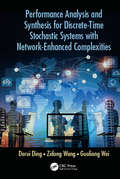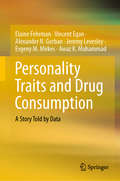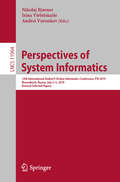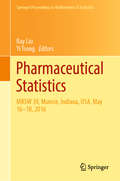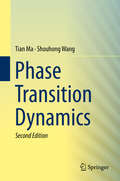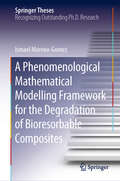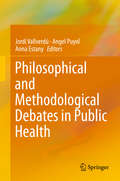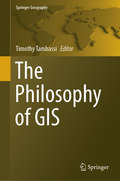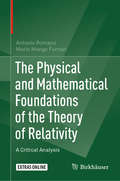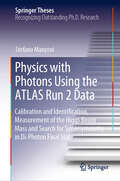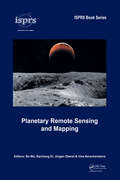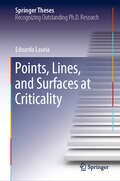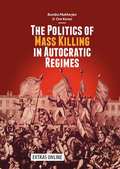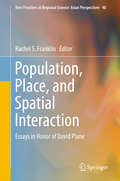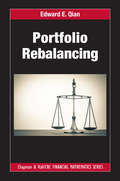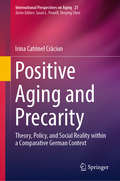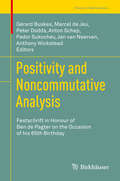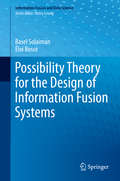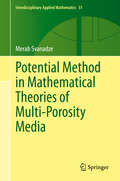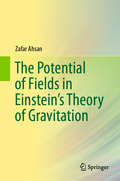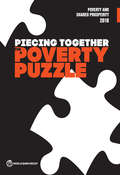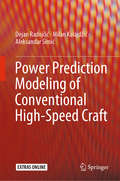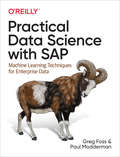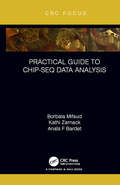- Table View
- List View
Performance Analysis and Synthesis for Discrete-Time Stochastic Systems with Network-Enhanced Complexities
by Derui Ding Zidong Wang Guoliang WeiThe book addresses the system performance with a focus on the network-enhanced complexities and developing the engineering-oriented design framework of controllers and filters with potential applications in system sciences, control engineering and signal processing areas. Therefore, it provides a unified treatment on the analysis and synthesis for discrete-time stochastic systems with guarantee of certain performances against network-enhanced complexities with applications in sensor networks and mobile robotics. Such a result will be of great importance in the development of novel control and filtering theories including industrial impact. <P><P>Key Features <li>Provides original methodologies and emerging concepts to deal with latest issues in the control and filtering with an emphasis on a variety of network-enhanced complexities <li>Gives results of stochastic control and filtering distributed control and filtering, and security control of complex networked systems <li>Captures the essence of performance analysis and synthesis for stochastic control and filtering <li>Concepts and performance indexes proposed reflect the requirements of engineering practice <li>Methodologies developed in this book include backward recursive Riccati difference equation approach and the discrete-time version of input-to-state stability in probability
Personality Traits and Drug Consumption: A Story Told by Data (SpringerBriefs in Statistics)
by Elaine Fehrman Vincent Egan Alexander N. Gorban Jeremy Levesley Evgeny M. Mirkes Awaz K. MuhammadThis book discusses the psychological traits associated with drug consumption through the statistical analysis of a new database with information on 1885 respondents and use of 18 drugs. After reviewing published works on the psychological profiles of drug users and describing the data mining and machine learning methods used, it demonstrates that the personality traits (five factor model, impulsivity, and sensation seeking) together with simple demographic data make it possible to predict the risk of consumption of individual drugs with a sensitivity and specificity above 70% for most drugs. It also analyzes the correlations of use of different substances and describes the groups of drugs with correlated use, identifying significant differences in personality profiles for users of different drugs. The book is intended for advanced undergraduates and first-year PhD students, as well as researchers and practitioners. Although no previous knowledge of machine learning, advanced data mining concepts or modern psychology of personality is assumed, familiarity with basic statistics and some experience in the use of probabilities would be helpful. For a more detailed introduction to statistical methods, the book provides recommendations for undergraduate textbooks.
Perspectives of System Informatics: 12th International Andrei P. Ershov Informatics Conference, PSI 2019, Novosibirsk, Russia, July 2–5, 2019, Revised Selected Papers (Lecture Notes in Computer Science #11964)
by Nikolaj Bjørner Irina Virbitskaite Andrei VoronkovThis book constitutes the refereed proceedings of the 12th International Andrei P. Ershov Informatics Conference, PSI 2019, held in Novosibirsk, Russia, in July 2019.The 18 full papers and 3 short papers presented in this volume were carefully reviewed and selected from 70 submissions. The papers cover various topics related to the Mathematics of Computing, Information Systems, Formal Languages, dependable and fault-tolerant Systems and Network, Automata Theory, and much more.
Pharmaceutical Statistics: MBSW 39, Muncie, Indiana, USA, May 16-18, 2016 (Springer Proceedings in Mathematics & Statistics #218)
by Ray Liu Yi TsongThis book presents the proceedings of the 39th annual Midwest Biopharmaceutical Statistics Workshop (MBSW), held in Muncie, Indiana on May 16–18, 2016. It consists of selected peer- reviewed and revised papers on topics ranging from statistical applications in drug discovery and CMC to biomarkers, clinical trials, and statistical programming. All contributions feature original research, and together they cover the full spectrum of pharmaceutical R&D – with a special focus on emergent topics such as biosimilarity, bioequivalence, clinical trial design, and subgroup identification.Founded in 1978, the MBSW has provided a forum for statisticians to share knowledge, research, and applications on key statistical topics in pharmaceutical R&D for almost forty years, with the 2016 conference theme being “The Power and 3 I’s of Statistics: Innovation, Impact and Integrity.” The papers gathered here will be of interest to all researchers whose work involves the quantitative aspects of pharmaceutical research and development, including pharmaceutical statisticians who want to keep up-to-date with the latest trends, as well as academic statistics researchers looking for areas of application.
Phase Transition Dynamics
by Tian Ma Shouhong WangThis book is an introduction to a comprehensive and unified dynamic transition theory for dissipative systems and to applications of the theory to a range of problems in the nonlinear sciences. The main objectives of this book are to introduce a general principle of dynamic transitions for dissipative systems, to establish a systematic dynamic transition theory, and to explore the physical implications of applications of the theory to a range of problems in the nonlinear sciences. The basic philosophy of the theory is to search for a complete set of transition states, and the general principle states that dynamic transitions of all dissipative systems can be classified into three categories: continuous, catastrophic and random. The audience for this book includes advanced graduate students and researchers in mathematics and physics as well as in other related fields.This second edition introduces a unified theory for topological phase transitions, provides a first-principle approach to statistical and quantum physics, and offers a microscopic mechanism of quantum condensates (Bose-Einstein condensation, superfluidity, and superconductivity). Reviews of first edition: “The goals of this interesting book are to derive a general principle of dynamic transitions for dissipative systems and to establish a systematic dynamic transition theory for a wide range of problems in the nonlinear sciences. … The intended audience for this book includes students and researchers working on nonlinear problems in physics, meteorology, oceanography, biology, chemistry, and the social sciences.” (Carlo Bianca, Mathematical Reviews, December, 2014) “This is a clearly written book on numerous types of phase transitions taken in a broad sense when a dynamical dissipative system transforms from one physical state into another. … The book is a very useful literature not only for the professionals in the field of dynamic systems and phase transitions but also for graduate students due to its interdisciplinary coverage and state-of-the-art level.” (Vladimir Čadež, zbMATH, Vol. 1285, 2014)
A Phenomenological Mathematical Modelling Framework for the Degradation of Bioresorbable Composites (Springer Theses)
by Ismael Moreno-GomezThis book presents a generalised computational model for the degradation of resorbable composites, using analytic expressions to represent the interwoven phenomena present during degradation. It then combines this modelling framework with a comprehensive database of quantitative degradation data mined from existing literature and from novel experiments, to provide new insights into the interrelated factors controlling degradation. Resorbable composites made of biodegradable polyesters and calcium-based ceramics have significant therapeutic potential as tissue engineering scaffolds, as temporary implants and as drug-loaded matrices for controlled release. However, their degradation is complex and the rate of resorption depends on multiple connected factors such as the shape and size of the device, polymer chemistry and molecular weight, particle phase, size, volume fraction, distribution and pH-dependent dissolution properties. Understanding and ultimately predicting the degradation of resorbable composites is of central importance if we are to fully unlock the promise of these materials.
Philosophical and Methodological Debates in Public Health
by Jordi Vallverdú Angel Puyol Anna EstanyThis interdisciplinary volume gathers selected, refereed contributions on various aspects of public health from several disciplines and research fields, including the philosophy of science, epidemiology, statistics and ethics. The contributions were originally presented at the 1st Barcelona conference of “Philosophy of Public Health” (5th – 7th May 2016). This book is intended for researchers interested in public health and the contemporary debates surrounding it.
The Philosophy of GIS (Springer Geography)
by Timothy TambassiThis anthology aims to present the fundamental philosophical issues and tools required by the reflection within and upon geography and Geographic Information Systems (GIS) . It is an introduction to the philosophy for GIScience from an analytical perspective, which looks at GIS with a specific focus on its fundamental and most general concepts and distinctions. The first part of the book is devoted to explore some of the main philosophical questions arising from GIS and GIScience, which include, among others, investigations in ontology, epistemology, linguistics and geometrical modeling. The second part concerns issues related to spatial and cartographical representations of the geographical world. The third part is focused on the ontology of geography, specifically in terms of geographical entities, objects and boundaries. Finally, in the fourth part, the topic of GIS constitutes a starting point for exploring themes such as quantum geography and disorientation, and for defining professional profiles for geographers with competences in GIS environment. This book on a new and unexplored field of research could be a fundamental point of reference for professional philosophers and geographers interested in the theoretical reflection about the foundational concepts of GIScience. It is also interesting reading material for students (both undergraduates, postgraduates and Ph.D. students) in philosophy, geography, applied ontology, GIScience, geomatics and computer science.
The Physical and Mathematical Foundations of the Theory of Relativity: A Critical Analysis
by Antonio Romano Mario Mango FurnariThis unique textbook offers a mathematically rigorous presentation of the theory of relativity, emphasizing the need for a critical analysis of the foundations of general relativity in order to best study the theory and its implications. The transitions from classical mechanics to special relativity and then to general relativity are explored in detail as well, helping readers to gain a more profound and nuanced understanding of the theory as a whole. After reviewing the fundamentals of differential geometry and classical mechanics, the text introduces special relativity, first using the physical approach proposed by Einstein and then via Minkowski’s mathematical model. The authors then address the relativistic thermodynamics of continua and electromagnetic fields in matter – topics which are normally covered only very briefly in other treatments – in the next two chapters. The text then turns to a discussion of general relativity by means of the authors’ unique critical approach, underlining the difficulty of recognizing the physical meaning of some statements, such as the physical meaning of coordinates and the derivation of physical quantities from those of space-time. Chapters in this section cover the model of space-time proposed by Schwarzschild; black holes; the Friedman equations and the different cosmological models they describe; and the Fermi-Walker derivative. Well-suited for graduate students in physics and mathematics who have a strong foundation in real analysis, classical mechanics, and general physics, this textbook is appropriate for a variety of graduate-level courses that cover topics in relativity. Additionally, it will interest physicists and other researchers who wish to further study the subtleties of these theories and understand the contemporary scholarly discussions surrounding them.
Physics with Photons Using the ATLAS Run 2 Data: Calibration and Identification, Measurement of the Higgs Boson Mass and Search for Supersymmetry in Di-Photon Final State (Springer Theses)
by Stefano ManzoniThe work presented in this book is based on the proton-proton collision data from the Large Hadron Collider at a centre-of-mass energy of 13 TeV recorded by the ATLAS detector in 2015 and 2016. The research program of the ATLAS experiment includes the precise measurement of the parameters of the Standard Model, and the search for signals of physics beyond the SM. Both these approaches are pursued in this thesis, which presents two different analyses: the measurement of the Higgs boson mass in the di-photon decay channel, and the search for production of supersymmetric particles (gluinos, squarks or winos) in a final state containing two photons and missing transverse momentum. Finally, ATLAS detector performance studies, which are key ingredients for the two analyses outlined before, are also carried out and described.
Planetary Remote Sensing and Mapping (ISPRS Book Series)
by Bo Wu Kaichang Di Jürgen Oberst Irina KarachevtsevaThe early 21st century marks a new era in space exploration. The National Aeronautics and Space Administration (NASA) of the United States, The European Space Agency (ESA), as well as space agencies of Japan, China, India, and other countries have sent their probes to the Moon, Mars, and other planets in the solar system. Planetary Remote Sensing and Mapping introduces original research and new developments in the areas of planetary remote sensing, photogrammetry, mapping, GIS, and planetary science resulting from the recent space exploration missions. <p><p>Topics covered include: <li>Reference systems of planetary bodies <li>Planetary exploration missions and sensors <li>Geometric information extraction from planetary remote sensing data <li>Feature information extraction from planetary remote sensing data <li>Planetary remote sensing data fusion <li>Planetary data management and presentation <p><p>Planetary Remote Sensing and Mapping will serve scientists and professionals working in the planetary remote sensing and mapping areas, as well as planetary probe designers, engineers, and planetary geologists and geophysicists. It also provides useful reading material for university teachers and students in the broader areas of remote sensing, photogrammetry, cartography, GIS, and geodesy.
Plasticity-Damage Couplings: From Single Crystal to Polycrystalline Materials (Solid Mechanics and Its Applications #253)
by Oana Cazacu Benoit Revil-Baudard Nitin ChandolaOffering a well-balanced blend of theory and hands-on applications, this book presents a unified framework for the main dissipative phenomena in metallic materials: plasticity and damage. Based on representation theory for tensor functions and scale-bridging theorems, this framework enables the development of constitutive models that account for the influence of crystallographic structures and deformation mechanisms on the macroscopic behavior. It allows readers to develop a clear understanding of the range of applicability of any given model, as well as its capabilities and limitations, and provides procedures for parameter identification along with key concepts necessary to solve boundary value problems, making it useful to both researchers and engineering practitioners. Although the book focuses on new contributions to modeling anisotropic materials, the review of the foundations of plasticity and models for isotropic materials, completed with detailed mathematical proofs mean that it is self-consistent and accessible to graduate students in engineering mechanics and material sciences.
Points, Lines, and Surfaces at Criticality (Springer Theses)
by Edoardo LauriaThis thesis offers a fascinating journey through various non-perturbative aspects of Conformal Theories, in particular focusing on the Conformal Bootstrap Programme and its extensions to theories with various degrees of symmetry. Because of the preeminent role of Conformal Theories in Nature, as well as the great generality of the results here obtained, this analysis directly applies to many different areas of research. The content of this thesis is certainly relevant for the physics community as a whole and this relevance is well motivated and discussed along the various chapters of this work.The work is self-contained and starts with an original introduction to conformal theories, defects in such theories and how they lead to constraints on data and an extension of the bootstrap programme. This situation is often realized by critical systems with impurities, topological insulators, or – in the high-energy context – by Wilson and 't Hooft operators. The thesis continues with original research results of the author, including supersymmetric extensions. These results may be relevant non only in the high energy physics context - where supersymmetry is required for the theory to be consistent - but also for condensed matter systems that enjoy supersymmetry emergence at long distances.
The Politics of Mass Killing in Autocratic Regimes
by Bumba Mukherjee Ore KorenThis book develops a detailed, disaggregated theoretical and empirical framework that explains variations in mass killing by authoritarian regimes globally, with a specific focus on Pakistan, Indonesia, and Malaysia. Using a combination of game-theoretic, statistical, and qualitative approaches, this project explicates when civilians within nondemocratic states will mobilize against the ruling elite, and when such mobilization will result in mass killing. In doing so, it illustrates the important role urbanization and food insecurity historically played, and will continue to play, in generating extreme forms of civilian victimization.
Population, Place, and Spatial Interaction: Essays in Honor of David Plane (New Frontiers in Regional Science: Asian Perspectives #40)
by Rachel S. FranklinThis volume is devoted to the geographical—or spatial—aspects of population research in regional science, spanning spatial demographic methods for population composition and migration to studies of internal and international migration to investigations of the role of population in related fields such as climate change and economic growth. If spatial aspects of economic growth and development are the flagship of the regional science discipline, population research is the anchor. People migrate, consume, produce, and demand services. People are the source and beneficiaries of national, regional, and local growth and development. Since the origins of regional science, demographic research has been at the core of the discipline. Contributions in this volume are both retrospective and prospective, offering in their ensemble an authoritative overview of demographic research within the field of regional science.
Portfolio Rebalancing (Chapman and Hall/CRC Financial Mathematics)
by Edward E. QianThe goal of Portfolio Rebalancing is to provide mathematical and empirical analysis of the effects of portfolio rebalancing on portfolio returns and risks. The mathematical analysis answers the question of when and why fixed-weight portfolios might outperform buy-and-hold portfolios based on volatilities and returns. The empirical analysis, aided by mathematical insights, will examine the effects of portfolio rebalancing in capital markets for asset allocation portfolios and portfolios of stocks, bonds, and commodities.
Positive Aging and Precarity: Theory, Policy, and Social Reality within a Comparative German Context (International Perspectives on Aging #21)
by Irina Catrinel CrăciunThis book explores positive aging through the lens of precarity, aiming to ground positive aging theories in current social contexts. In recent years, research on aging has been branded by growing disagreements between supporters of the successful aging model and critical gerontologists who highlight the widening inequalities, disadvantages and precarity that characterize old age. This book comes to fill a gap in knowledge by offering an alternative view on positive aging, informed by precarity and its impact on projections concerning aging.The first part of the book places aging in broader theoretical and empirical context, exploring the complex links between views on aging, successful aging theories, policy and social reality. The second part uses results from a qualitative research conducted in Germany to illustrate the dissonance between successful aging ideals and both negative and positive views on aging as well as aging preparation strategies inspired by precarity. Findings from this section provide a solid starting point for comparisons with countries that are both similar and different from Germany in terms of welfare regimes and aging policies. The final part of the book discusses the psychological implications of these findings within and beyond the German case study and outlines potential solutions for practice. This book provides health psychologists, gerontologists, sociologists, social workers, health professionals as well as students and aging individuals themselves with better understanding of the meaning of aging in precarious times and builds confidence about aging well despite precarity.
Positivity and Noncommutative Analysis: Festschrift in Honour of Ben de Pagter on the Occasion of his 65th Birthday (Trends in Mathematics)
by Jan Van Neerven Gerard Buskes Marcel De Jeu Peter Dodds Anton Schep Fedor Sukochev Anthony WicksteadCapturing the state of the art of the interplay between positivity, noncommutative analysis, and related areas including partial differential equations, harmonic analysis, and operator theory, this volume was initiated on the occasion of the Delft conference in honour of Ben de Pagter's 65th birthday. It will be of interest to researchers in positivity, noncommutative analysis, and related fields. Contributions by Shavkat Ayupov, Amine Ben Amor, Karim Boulabiar, Qingying Bu, Gerard Buskes, Martijn Caspers, Jurie Conradie, Garth Dales, Marcel de Jeu, Peter Dodds, Theresa Dodds, Julio Flores, Jochen Glück, Jacobus Grobler, Wolter Groenevelt, Markus Haase, Klaas Pieter Hart, Francisco Hernández, Jamel Jaber, Rien Kaashoek, Turabay Kalandarov, Anke Kalauch, Arkady Kitover, Erik Koelink, Karimbergen Kudaybergenov, Louis Labuschagne, Yongjin Li, Nick Lindemulder, Emiel Lorist, Qi Lü, Miek Messerschmidt, Susumu Okada, Mehmet Orhon, Denis Potapov, Werner Ricker, Stephan Roberts, Pablo Román, Anton Schep, Claud Steyn, Fedor Sukochev, James Sweeney, Guido Sweers, Pedro Tradacete, Jan Harm van der Walt, Onno van Gaans, Jan van Neerven, Arnoud van Rooij, Freek van Schagen, Dominic Vella, Mark Veraar, Anthony Wickstead, Marten Wortel, Ivan Yaroslavtsev, and Dmitriy Zanin.
Possibility Theory for the Design of Information Fusion Systems (Information Fusion and Data Science)
by Basel Solaiman Éloi BosséThis practical guidebook describes the basic concepts, the mathematical developments, and the engineering methodologies for exploiting possibility theory for the computer-based design of an information fusion system where the goal is decision support for industries in smart ICT (information and communications technologies). This exploitation of possibility theory improves upon probability theory, complements Dempster-Shafer theory, and fills an important gap in this era of Big Data and Internet of Things.The book discusses fundamental possibilistic concepts: distribution, necessity measure, possibility measure, joint distribution, conditioning, distances, similarity measures, possibilistic decisions, fuzzy sets, fuzzy measures and integrals, and finally, the interrelated theories of uncertainty..uncertainty. These topics form an essential tour of the mathematical tools needed for the latter chapters of the book. These chapters present applications related to decision-making and pattern recognition schemes, and finally, a concluding chapter on the use of possibility theory in the overall challenging design of an information fusion system. This book will appeal to researchers and professionals in the field of information fusion and analytics, information and knowledge processing, smart ICT, and decision support systems.
Potential Method in Mathematical Theories of Multi-Porosity Media (Interdisciplinary Applied Mathematics #51)
by Merab SvanadzeThis monograph explores the application of the potential method to three-dimensional problems of the mathematical theories of elasticity and thermoelasticity for multi-porosity materials. These models offer several new possibilities for the study of important problems in engineering and mechanics involving multi-porosity materials, including geological materials (e.g., oil, gas, and geothermal reservoirs); manufactured porous materials (e.g., ceramics and pressed powders); and biomaterials (e.g., bone and the human brain). Proceeding from basic to more advanced material, the first part of the book begins with fundamental solutions in elasticity, followed by Galerkin-type solutions and Green’s formulae in elasticity and problems of steady vibrations, quasi-static, and pseudo-oscillations for multi-porosity materials. The next part follows a similar format for thermoelasticity, concluding with a chapter on problems of heat conduction for rigid bodies. The final chapter then presents a number of open research problems to which the results presented here can be applied. All results discussed by the author have not been published previously and offer new insights into these models.Potential Method in Mathematical Theories of Multi-Porosity Media will be a valuable resource for applied mathematicians, mechanical, civil, and aerospace engineers, and researchers studying continuum mechanics. Readers should be knowledgeable in classical theories of elasticity and thermoelasticity.
The Potential of Fields in Einstein's Theory of Gravitation
by Zafar AhsanThis book presents a detailed study of the Lanczos potential in general relativity by using tetrad formalisms. It demonstrates that these formalisms offer some simplifications over the tensorial methods, and investigates a general approach to finding the Lanczos potential for algebraic space–time by translating all the tensorial relations concerning the Lanczos potential into the language of tetrad formalisms and using the Newman–Penrose and Geroch–Held–Penrose formalisms. In addition, the book obtains the Lanczos potential for perfect fluid space–time, and applies the results to cosmological models of the universe. In closing, it highlights other methods, apart from tetrad formalisms, for finding the Lanczos potential, as well as further applications of the Newman–Penrose formalism. Given its scope, the book will be of interest to pure mathematicians, theoretical physicists and cosmologists, and will provide common ground for communication among these scientific communities.
Poverty and Shared Prosperity 2018: Piecing Together the Poverty Puzzle (Poverty and Shared Prosperity)
by World BankThe World Bank Group has two overarching goals: End extreme poverty by 2030 and promote shared prosperity by boosting the incomes of the bottom 40 percent of the population in each economy. As this year’s Poverty and Shared Prosperity report documents, the world continues to make progress toward these goals. In 2015, approximately one-tenth of the world’s population lived in extreme poverty, and the incomes of the bottom 40 percent rose in 77 percent of economies studied. But success cannot be taken for granted. Poverty remains high in Sub- Saharan Africa, as well as in fragile and conflict-affected states. At the same time, most of the world’s poor now live in middle-income countries, which tend to have higher national poverty lines. This year’s report tracks poverty comparisons at two higher poverty thresholds—$3.20 and $5.50 per day—which are typical of standards in lower- and upper-middle-income countries. In addition, the report introduces a societal poverty line based on each economy’s median income or consumption. Poverty and Shared Prosperity 2018: Piecing Together the Poverty Puzzle also recognizes that poverty is not only about income and consumption—and it introduces a multidimensional poverty measure that adds other factors, such as access to education, electricity, drinking water, and sanitation. It also explores how inequality within households could affect the global profile of the poor. All these additional pieces enrich our understanding of the poverty puzzle, bringing us closer to solving it. For more information, please visit worldbank.org/PSP
Power Prediction Modeling of Conventional High-Speed Craft
by Dejan Radojčić Milan Kalajdžić Aleksandar SimićThe proposed book addresses various power prediction methods, a principal design objective for high-speed craft of displacement, semi-displacement, and planing type. At the core of the power prediction methods are mathematical models based on experimental data derived from various high-speed hull and propeller series. Regression analysis and Artificial Neural Network (ANN) methods are used as extraction tools for this kind of models.The most significant factors for in-service power prediction are bare hull resistance, dynamic trim, and the propeller’s open-water efficiency. Therefore, mathematical modeling of these factors is a specific focus of the book. Furthermore, the book includes a summary of most of the power-prediction-relevant literature published in the last 50 years, and as such is intended as a reference overview of the best high-speed craft modeling practices.Once these mathematical models have been developed and validated, they can be readily programmed into software tools, thereby enabling the parametric analyses required for the optimization of a high-speed craft design. The proposed book is intended primarily for naval architects who design and develop various types of high-speed vessels (yachts, boats etc.), as well as for students who are interested in the design of fast vessels. The book includes useful Excel Macro Codes for the outlined mathematical models. Moreover, software for all considered models is provided.
Practical Data Science with SAP: Machine Learning Techniques for Enterprise Data
by Greg Foss Paul ModdermanLearn how to fuse today's data science tools and techniques with your SAP enterprise resource planning (ERP) system. With this practical guide, SAP veterans Greg Foss and Paul Modderman demonstrate how to use several data analysis tools to solve interesting problems with your SAP data.Data engineers and scientists will explore ways to add SAP data to their analysis processes, while SAP business analysts will learn practical methods for answering questions about the business. By focusing on grounded explanations of both SAP processes and data science tools, this book gives data scientists and business analysts powerful methods for discovering deep data truths.You'll explore:Examples of how data analysis can help you solve several SAP challengesNatural language processing for unlocking the secrets in textData science techniques for data clustering and segmentationMethods for detecting anomalies in your SAP dataData visualization techniques for making your data come to life
Practical Guide to ChIP-seq Data Analysis (Focus Computational Biology Series)
by Borbala Mifsud Kathi Zarnack Anaïs F BardetChromatin immunoprecipitation sequencing (ChIP-seq), which maps the genome-wide localization patterns of transcription factors and epigenetic marks, is among the most widely used methods in molecular biology. Practical Guide to ChIP-seq Data Analysis will guide readers through the steps of ChIP-seq analysis: from quality control, through peak calling, to downstream analyses. It will help experimental biologists to design their ChIP-seq experiments with the analysis in mind, and to perform the basic analysis steps themselves. It also aims to support bioinformaticians to understand how the data is generated, what the sources of biases are, and which methods are appropriate for different analyses.
